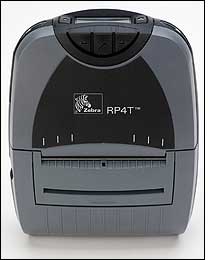Zebra Technologies says it has developed the industry’s first wearable RFID printer-encoder that supports both thermal transfer and direct thermal printing technologies. The mobile device also contains an interrogator module manufactured by ThingMagic, enabling it to read and encode passive ultrahigh-frequency (UHF) RFID tags compliant with the EPC Gen 2 standard. The company plans to release the unit, known as the RP4T, later this year.
“This product, for us, is a first in a number of different areas, and we’re excited about the launch,” says Bob Danahy, Zebra’s director of desktop, mobile and wireless technology. “We think it opens a lot of doors for us.” The ability to print RFID labels using thermal transfer is important, he explains, because this process creates a longer-lasting label that is less prone to fading over time than those printed with direct transfer. Having the two printing technologies—thermal transfer and direct thermal—built into the device makes the RP4T versatile, he says.
According to Danahy, a mobile RFID printer-encoder will simplify the creation of RFID labels for placement on high-value assets and reusable containers, or for use as shelf-edge labels within a warehouse. Workers could create the labels right at the location of the items to be tagged, such as inside an industrial yard, rather than using a desktop printer located back in a central location. “This product makes sense anywhere you have label printing requirements that are on demand and in remote locations, and [where the label is subject to] extreme conditions, such as bright sunlight, or in hot, wet or cold climates,” he says. Because these types of labels would need to be long-lasting, an end user could opt for the RP4T’s thermal transfer printing.
Although thermal transfer creates labels that are more durable and resistant to UV damage than labels created by direct thermal printing, it is also a more expensive process than direct thermal. So if an end user wants to tag cases of fast-moving consumer goods that would be sold quickly, the direct thermal print function would likely be employed. However, Danahy adds, because most RFID labels that are applied to skids of materials are placed on trucks or shipping containers—where they may be stored for a long time and be exposed to variations in light and temperature—thermal transfer is currently used by the majority of RFID printer-encoders.
The wearable printer will also enable end users to quickly print RFID labels for labeling cases or pallets of goods being cross-docked, wherein the pallets are broken down and the cases are divided and re-palleted. To do this, the printer would employ a Wi-Fi or Bluetooth communications link to connect with the user’s back-end software and download shipping data and EPCs to be encoded to the labels.
The RP4T measures 8.6 inches high by 7 inches wide and 3 inches deep, and weighs 2.9 pounds, including a printing ribbon and a battery. It can be worn on a belt around the waist or on a shoulder strap, or it can be mounted onto a lift truck, powered by the truck’s battery. When used on a lift truck, an external label-feeding option can be employed, increasing the number of labels it can print compared with the smaller stock of labels that can be stored within the printer when used as a fully mobile device.
Pricing for the RP4T has not yet been released.


